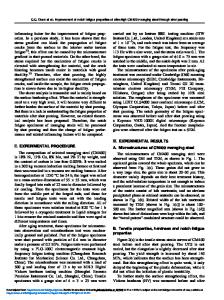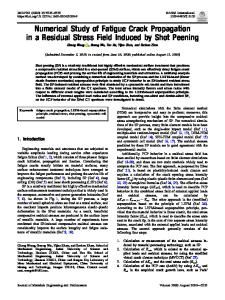Effect of Shot Peening on Fatigue Properties of Zr-based Amorphous Matrix Composites
- PDF / 515,243 Bytes
- 6 Pages / 612 x 792 pts (letter) Page_size
- 94 Downloads / 313 Views
Effect of Shot Peening on Fatigue Properties of Zr-based Amorphous Matrix Composites
Changwoo Jeon, Choongnyun Paul Kim, and Sunghak Lee Center for Advanced Aerospace Materials Pohang University of Science and Technology, Pohang 790-784, Korea
Abstract Effects of shot peening on fatigue properties of Zr-based amorphous matrix composite containing ductile crystalline particles were investigated, and fatigue processes were analyzed and compared with those of an as-cast composite. The microstructural analysis results of the shot-peened composite surface indicated that the deformation and surface flexion were observed as the shot-peening time or pressure increased. The compressive residual stress formed on the shot-peened surface was about the half of the ultimate tensile strength, and was not varied much with shot-peening time or pressure. The fatigue limit and fatigue ratio of the shot-peened composite were considerably higher than those of the as-cast composite. This was because the compressive residual stress formed by the shot peening induced the initiation of fatigue cracks at the specimen interior, instead of the specimen surface, thereby leading to the enhanced fatigue limit and fatigue life.
1. Introduction Though Zr-based monolithic amorphous alloys have very high tensile strength, but their fatigue limits are 6~9 % of tensile strength, which is a quite low level of fatigue limit, comparing with 30~40 % of tensile strength in conventional high-strength steels or aluminum alloys [1]. Once a crack initiates in a Zr-based a monolithic amorphous alloy, the abrupt fracture occurs within limited fatigue cycles, thereby resulting in the lowered fatigue limit [2]. This implies that the damage during the fatigue crack initiation occupies most of the fatigue life. The fabrication of amorphous matrix composites containing ductile crystalline particles is a good solution for preventing or modifying the abrupt fatigue crack initiation and propagation [3,4]. In these amorphous matrix composites, the fatigue limit as well as ductility and fracture toughness are improved as ductile particles effectively block the propagation of shear bands formed in the amorphous matrix [2,4]. As another way for improving fatigue limit in Zr-based amorphous alloys or composites, the formation of compressive residual stresses on the surface by shot
peening has been suggested [5]. These compressive residual stresses help the homogeneous deformation of the alloys or composites, which leads to two or three time improvement in ductility or fatigue limit. In the present study, thus, fatigue properties of a shot-peened Zr-based amorphous matrix composite containing ductile crystalline particles were investigated, and fatigue processes were analyzed and compared with those of a non-shot-peened amorphous matrix composite.
2. Experimental The used Zr-based amorphous matrix composite was an 'LM2' alloy (commercial brand name of the Liquidmetal Technologies, Lake Forest, CA, U.S.A), whose composition was Zr56.2Ti13.8Nb5.0Cu6.9Ni5.6Be12.5 (at. %). T
Data Loading...











